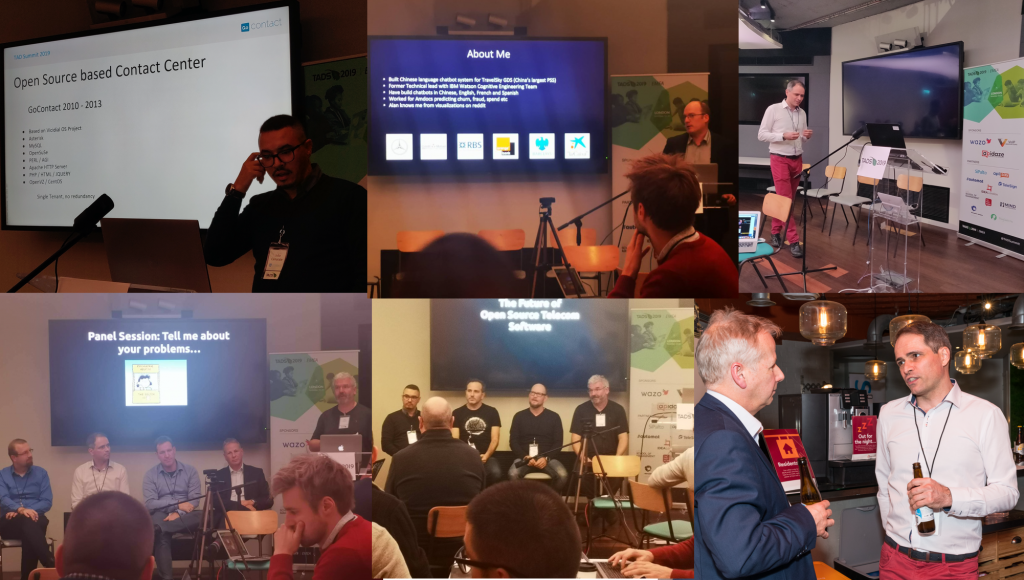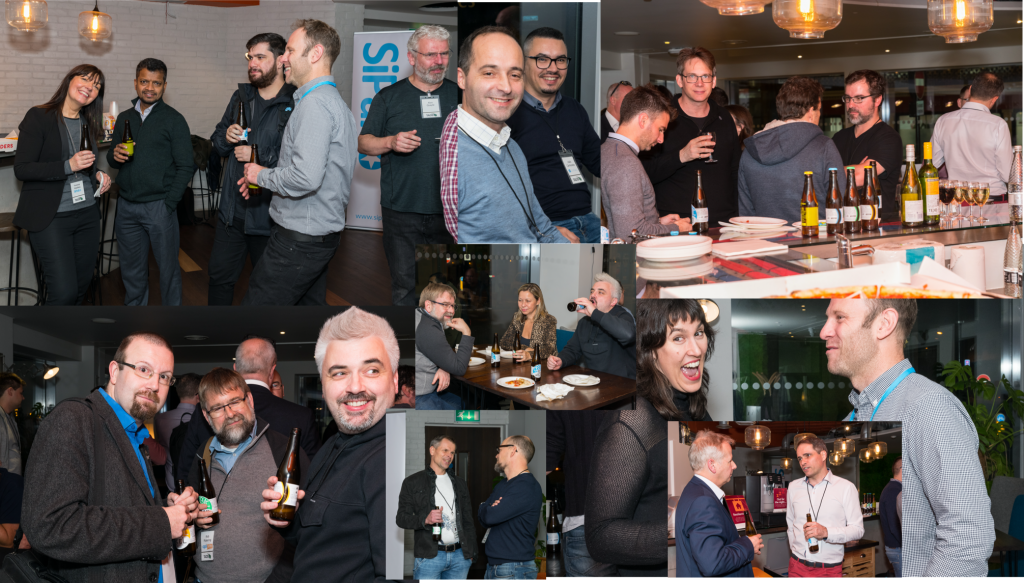The afternoon of Day One TADSummit EMEA was split in two sessions: one focused on Open Source Telecom Software; and the other focused on Industry Innovation, that is, examining innovation from other industries and and how they apply it to the problems they face.
In-between we squeezed in a presentation from David Curran from OpenJaw Technologies who could not make his scheduled Day 2 slot, David gave an excellent chat bot primer with loads of practical advice. The new microphone we used to improve audio, didn’t occasionally do that 🙁 So rather than frustrate you in listening to distorted audio, I’ve annotated the key points from some of the presentations.
I kicked off the open source session with a presentation summarizing the results from an anonymous survey of open source telecom software. Comparing the different projects, the preferred application areas of the projects, common issues and solutions, sharing where the industry sees these projects in 5 years’ time.
João Camarate, Chief Development Officer, GoContact presented on “Experiences with Open Source Telecom Software in the Contact Center Industry.”
João frankly shared his experiences and recommendations in using open source telecom software in the contact center industry. Reviewing the different platforms, the rationale behind the selection and application focus. How he de-risks decisions to ensure continuity of service. Current challenges and open discussion on the emerging programmable telecoms architecture. We need many more of this implementation presentations to help share best practices and solutions to common problems.
Panel Discussion: The Future of Open Source Telecom Software
Chair: Sebastian Schumann, Technology & Innovation at Deutsche Telekom
Panelists:
- João Camarate, Chief Development Officer, GoContact
- Alan Quayle, Independent
- Werner Eriksen, CTO WorkingGroupTwo
- Jérôme Pascal, CEO, Wazo
Questions:
- Imagine you are going to start a new product around Telecoms. Considering what you know today would you decide to build your own Telecom stack or use a Telecom API like Twilio ?
- Is native Cloud really an unpopular choice for open source implementations? Why?
- Can integrated automation and containerization drive cloud-native deployments?
- Are we missing the impact of containers/playbooks/recipes on open-source comms software as part of the community output?
- Could a “simple open-source based CPaaS stack” enable carriers at large to make their network programmable?
- What’s the impact of WebRTC on classic open-source comms apps?
- Many new stacks evolved, but how relevant are these?
- What’s the future of Asterisk and FreeSwitch?
- As Kamailio and OpenSIPS diverge, will the love remain? Does competition between projects help? Or is it something else?
- What questions would you like the open source telecom software project survey to ask next time?
A common discussion topic was the containerization of open source software, and when we’d see serverless approaches. The Industry Innovation session showed serverless is considered the standard approach to innovation, minimizing effort spent on infrastructure ‘blocking and tackling’ or “Yak Shaving” using Matt Millar’s analogy. Rather focusing on application architecture and design. Granted real time communications does impact that decision at scale, there is going to be a tipping point within the next couple of years. And for low volume experimentation RTC and serverless is possible today.
David Curran, Machine Learning Engineer at OpenJaw Technologies presented on “Designing and Deploying Chatbots.”
David provided a down-to-earth review of the current status of chatbots based on his extensive experience. No hype, just facts. He will then focus on a number of chatbots case studies given his extensive deployment experience. Explaining the impact of the local culture and language on chatbots. And highlighting some of the unique aspects of chatbots in for example in China compared to the rest of the world that will accelerate the Chinese chatbot industry faster than anywhere else. Could Asia become the chatbot center of the world?
I’ve annotated David’s presentation indexed on the slides, given the audio issues, but we now also have a good video recording as well, see below. I consider this presentation to be the best summary of the state of the art in chatbot technology available.
Slide 1: For anyone involved in contact centers, chatbots, fraud or churn management – were they are making predictions, this presentation has useful information.
Slide 4: David brings a wealth of practical machine learning experience from IBM Watson Cognitive Engineering Team, as well as doing a stint in telco with Amdocs. And has build chat bots, mostly text based, across multiple languages. I regularly see David’s data visualization posts on Reddit.
Slide 5: OpenJaw has about 450 employees, providing e-Commerce platforms for travel companies and loyalty programs, transforming travel providers into travel retailers by encouraging them to own, engage and service their customers thereby increasing their revenue, margins and improving the customer experience. Of which chatbots is where David focuses. Machine Learning technology is now at a point where small and medium sized companies are focused on particular industry verticals.
Slide 12: This is the best definition I’ve seen of chatbots:
- A Chatbot is a computer program which conducts a conversation
- Chatbots imitate human conversations using artificial intelligence to perform tasks
- Chatbots help answer question from known data sources
- Chatbots are a dialogue for things like customer service or information acquisition.
- Conversation can be voice or text.
Slide 16: The biggest problem is getting your data from within the organization to train the bot. DO NOT MAKE UP DATA.
Slides 19-23: The reasons in the travel industry to adopt a chat bot are:
- For text, it’s where your customers are. Call center requires dedicated time of the customer, while with chat the customer can multi-task. It’s faster, as it avoids menu-trees. A bot is about making your service better for customers not cheaper. It is expensive to build a bot, so do not assume cost savings are an immediate drive.
- Common use cases that can be solved through the bot can save money, for example in some languages like Norwegian / Germany, where the cost to answer a call is $10.
- And there’s new revenue opportunities through cross-sell and up-sell. But this only applies after 18 months, when the bots are working well in simply improving customer experience.
Slide 26: This is critical for the marketing folks. The tone of the chatbot – friendly and a little cheeky, mature and trustworthy, myst reflect the brand. This part of chatbot design is often overlooks, yet has a big impact on how authentic customers feel the communication is.
Slide 29-32: Intent is what people want to do when they contact a brand. Focus on the most popular. There a many ways to ask the same question. DO NOT MAKE UP DATA. You must use the customer voice, not the agent’s voice as they translate into internal jargon. The points David makes here are critical to chatbot success.
Slide 39. This timeline in creating a chatbot is spot-on:
- Decide Personality to make the brand (1-2 weeks)
- Gather Questions (can take from a few weeks to months)
- Classify Questions – Accuracy + Confidence (2 weeks)
- Write Answers (2 weeks)
- Run customer tests. Rinse and repeat – Gather, Classify, Tweak (2 weeks)
Solving Harry Potter Problems by Maarten Ectors, Chief Innovation Officer at Legal & General. An inspirational presentation from someone shaking-up the insurance industry.
Maarten has created a highly successful innovation process in Legal and General delivering award winning innovations. I share here the core of his process:
- Problem capture, where he gave the example of improving the claims experience for honest customers, and making it harder for dishonest customers.
- 5 minute RFIs. Its 5 minutes for the customer to experience the solution and provide feedback. This is an iterative process to get to a MVP (Minimum Viable Product).
- Serverless and continuous deployment, to both refine and scale-up the solution as it rolls-out.
It’s not about technology, and everything to do in finding as rapidly as possible a solution to a business problem and then scaling it up. Keep an eye on what Maarten is doing at Legal and General its a great example of how in a mature highly regulated industry, change can happen fast.
Open Banking by Miles Cheetham, Head of Propositions at OPEN BANKING. A review of the challenges and opportunities facing the banking industry. Open Banking puts customers in control of their data: it’s an easier way to move, manage, and make more of their money.
I’ve been following OPEN BANKING since Miles moved there. It’s taken some time but it’s now driving significant change in retail banking. They’ve created a framework that can be applied to other industries. There’s a consultation happening on Open Telecoms, so this is a space to watch in the UK.
Panel Session: Tell me about your problems…
- Maarten Ectors, Chief Innovation Officer at Legal & General
- Steve Goodwin, Marquis de Geek
- Matt Millar, serial entrepreneur, Founder Uplift
- Miles Cheetham, Head of Propositions at OPEN BANKING (entity set up by the UK Competition and Markets Authority)
The objective is to stimulate discussion on potential solutions to the problems presented, and kick off some projects! Yes, a conference that not only connects people, but stimulated new projects and business!
Purely by luck we had Matt Millar, serial entrepreneur, Founder Uplift on the panel with Miles. Updraft is a finalist of Open Up 2020 is run by Nesta Challenges and backed by the Open Banking Implementation Entity as part of the UK’s world-leading open banking agenda.
It was great to have such a diverse panel. Most of the discussion focused on understanding Open Banking. I did ask Steve a question on where he saw the gaps in CPaaS. He provided some excellent advice to the CPaaS providers in the room based on his extensive experience in using APIs, code samples, code samples, and more code samples.
Day 1 Evening Reception sponsored by Sipalto
After a long day and intense Industry Innovation panel we wrapped up the day with some drinks and pizza sponsored by Sipalto, continuing the discussions into the evening.
We managed to squeeze in a Hot Telecom interview by Isabelle Paradis, where I explained a little of TADSummit’s history and its relevance for telcos / carriers. Bottom-line, you have to roll your own services, as the providers telcos’ are reselling now compete with them. Open Source telecom software is ever more important to the future of carriers’ communications services.


